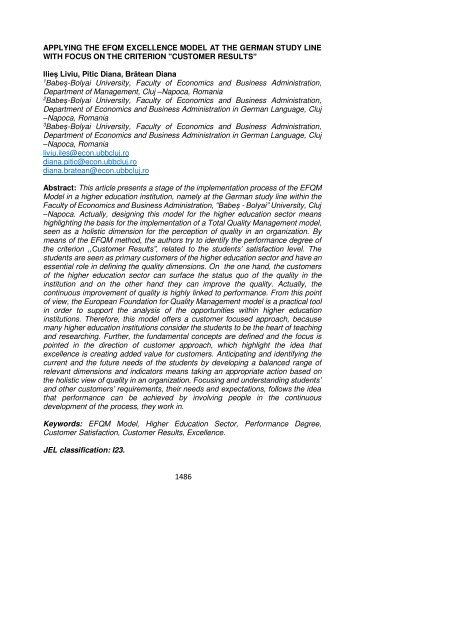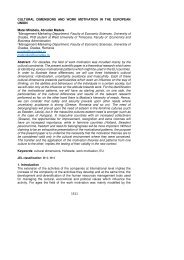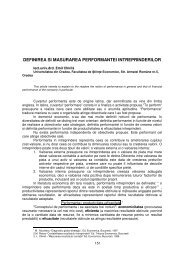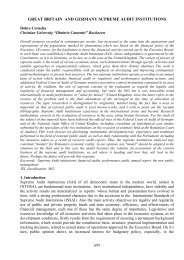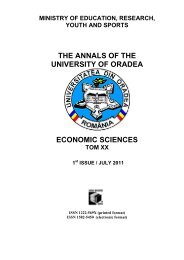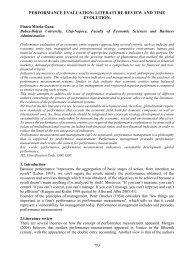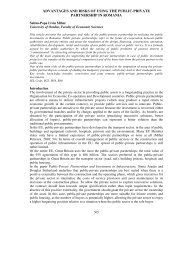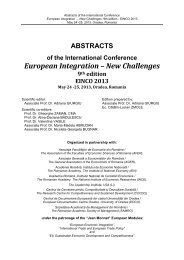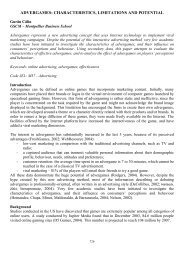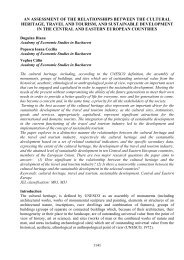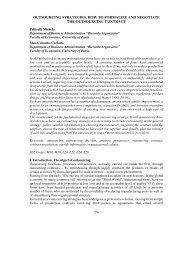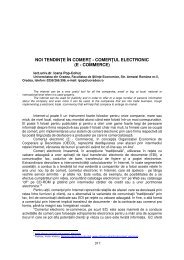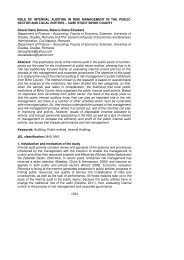APPLYING THE EFQM EXCELLENCE MODEL AT THE GERMAN ...
APPLYING THE EFQM EXCELLENCE MODEL AT THE GERMAN ...
APPLYING THE EFQM EXCELLENCE MODEL AT THE GERMAN ...
- No tags were found...
Create successful ePaper yourself
Turn your PDF publications into a flip-book with our unique Google optimized e-Paper software.
organization;the model is designed to suit to individual organizations;the method offers a way in which a common focus can provide a new wayof working in the organization;it also provides a balanced set of results indicators;it has been tested in a range of sectors;it provides a framework through the kernel of a certain organizations’ issuescan be surfaced and improved.It is also to be noted, that the academic culture plays an important role whenimplementing an <strong>EFQM</strong> model in the higher education institutions. Galler andGhobadian (2004) state, that the successful adoption and practice of QualityManagement requires probably modification to organizational culture. Davies(2007) admits that there is support for carrying out the cultural assessment beforeimplementing a quality management model in order to identify potential barriers andhelp in designing the implementation program.This article illustrates the results of the performance degree of the customersatisfaction; this dimension being integrated in the results section. Mainly, thesection “customer results” is structured in the sub criterion customer perception andinternal indicators. This research illustrates the results obtained by analyzing theBachelor students’ perception regarding the quality of the educational services atthe German study line.3. MethodologyThe paper seeks to explore the performance degree of the criterion “customerresults”. The research question which emerged from the above literature review is,Which is the performance degree of the criterion “customer results?”. In order to geta variety of perspectives, the authors designed a questionnaire with 27 items thatfocus on quality dimensions regarding the students’ satisfaction. The first section isfocused in the direction of teaching and learning process, the second section in thedirection infrastructure and the last section reveals the dimension “opportunities andservice provided”. We also ask the survey respondents to give suggestions forimprovement for the above mentioned dimensions. The questionnaire was given tothe Bachelor students at the German study line at the Faculty of Economics andBusiness Administration and a response rate of 72% was registered.For this study, the authors used as statistical method the mean in order to identifythe students’ degree of satisfaction for the provided educational service (Table 1).Table 1: Mean Values for the Bachelor studentsTeaching and Learning ProcessesMean1. The curriculum of the specializations at the German study line 3.3210presented on the web site of the faculty is useful and easyaccessible2. The knowledge gained within classes represent a good mix of 3.0988theory and practice3. The information about the elective courses are helpful, complete 3.2840and available on time4. The inclusion of both domestic and foreign teachers provide a 3.7099successful mix of knowledge and skills1490
5. The teachers are available during tutorials whatever questions 3.9753you may have6. I also take the opportunity in visiting the teachers during the office 3.1790hours within a semester7. The tutors of all the specializations ensure adequate support 3.3457during the academic year8. During classes, soft-skills are also required (teamwork, 3.2531communication skills, practical skills, etc.)9. The presence at the course is a prerequisite for the acquisition of 3.2963the specialized knowledge10. A reasonable timetable contains 2-3 units daily 3.395111. The knowledge acquired within all subjects in one semester are 3.2222accessible, complete and appropriate12. The language level at the courses meets my expectations 3.456813. The difficulty of the taught material and the learning effort for the 3.2963exam preparation are in balance14. The rating system should be composed of several units (exam, 3.6235homework, projects, attendance, etc.)15. The final results of the tests are subject to the principle of fairness 3.530916. The chances and opportunities to find a job as a graduate of the 3.9630German study line provide a comparative advantage over othergraduatesInfrastructure17. The premises have appropriate equipment (number of seats, 3.6049heating, acoustics)18. The technical equipment to carry out educational activities is in 3.7716line with the expectations19. I visit the “Robert-Bosch” library of the German study line at the 2.5185during the semester and am aware of the current books fund20. I am aware of the economic books fund at the Austrian library, 2.5926the library of the German Cultural Centre and the GermanInstituteOpportunities and Services provided21. I am satisfied with the administration service ( secretary) 3.129622. The referee at the German study line informs me fully and on time 3.4630about all organizational news and events on course23. There is a reasonable amount of information about scholarships 3.4877and internship opportunities24. The opportunities for the recognition of professional services with 3.3889the scope of awards (Rehau, EBS, etc.) are meaningful25. The representative of the students of the German Study Line 2.9630within the Council of the Faculty is known to me26. I am fully aware of his duties. I also feel that my sphere of interest 2.9259are well represented27. The existing student organizations act to strengthen the 3.1974intercultural competencies. I am therefore ready to participateactively in such an organization.1491
4. ResultsFurther, in order to apply the <strong>EFQM</strong> Model at the German study line, the statisticalvalues form the above table were integrated in the RADAR model. Supported by theRadar logic (Figure 2) the organization can systematically set goals (Results),develop actions ( Approach) in order to achive these goals, implement a plan forthese actions (Deployment) and finally analyse the action plan and itsimplementation ( Assemssment and Review) (McCarthy, Gratbanks and Yang,2002).Figure 2: RADAR matrix cycle for the methodology of <strong>EFQM</strong> Excellence ModelSource: adapted after McCarthy, Gratbanks and Yang (2002)According to Sohovic, Pavletic and Kern Pipan (2010) the tool of RADAR Matrix isused for the assesment of organizational performance and applied within the <strong>EFQM</strong>Excellence Model. The matrix is structured in five columns, each of the columnbeeing responsible for the achievement of a certain degree of performance, namelybetween 0 % and 100 % for each subcriteria of the criterion ,, customer results”.In this case, there exist 27 subcriteria afferent to each question regarding the degreeof students’ satisfaction. The authors took into consideration the following structure(Table 2) for the implementation of the RADAR logic in accordance with the meanvalues.Table 2: Correlation between performance degree and satisfaction level accordingto mean valuesPerformance Degree 0% 25% 50% 75% 100%Satisfaction Level (Likert–Skale): Mean Values1-1,5 1,5-2 2-3 3-4 4-5Moreover, the RADAR matrix for the above mentioned results are illustrated inTable 3.1492
Theorem 3. There is no FPTAS for the Shapley value, even for games that areboth supermodular and monotone.Proof. Assume that such an algorithm exists. For any n, we take ε = 1/2n.The algorithm must ε-approximate a player i’s Shapley value with only poly(n)oracle calls. Define A i = {A : |A| = n/2 and i ∈ A}. Assume that the oracleresponds to all queries as if the game is v ∅ , and let Q i ⊆ A i be the collection ofsets among A i queried by the algorithm. Then these queries cannot distinguishbetween the games v ∅ and v Ai\Q i. The Shapley values for player i in these twogames are1 and 1 + 1 n − |Q i|) , n( n−1n/2−1respectively. Because |Q i | is polynomial in n, and ( n−1n/2−1)grows faster than anypolynomial, we may take n large enough so that |Q i |/ ( n−1n/2−1)< 1/2. In this case,the purported algorithm cannot distinguish between two games whose Shapleyvalues differ by a multiplicative factor of ε = 1/2n, as was required. Therefore,such an algorithm cannot exist.The randomized sampling algorithm from Section 3 requires poly(n, 1/ε)time to ε-approximate Shapley values. In other words, for any polynomial q(m),we can get a 1/q(m) approximation in poly(n, m) time. One might hope for abetter algorithm—for example, a 1/2 m approximation in poly(n, m) steps. Wenow apply Yao’s Minimax Principle to show that no such algorithm exists ( [3]uses a similar argument).Theorem 4. Suppose ε(m) is a function that converges to zero faster than1/q(m) for any polynomial q(m). Then no randomized algorithm can ε(m)-approximate the Shapley value of an n-player monotone supermodular game inpoly(n, m) time.Proof. Yao’s Minimax Principle [43] states that it suffices to prove that no deterministicpolynomial-time algorithm can give an ε(m) approximation on anyparticular probability distribution of games. We define the distribution as follows.Let i be a particular player, let A i = {A : |A| = n/2 and i ∈ A}, andlet k = ε(n) ( n−1n/2−1)n. (Assume that n is large enough that ε(n) < 1/n.) Withprobability 1/2, we choose the game v ∅ , and with probability 1/2 we chooseuniformly at random a subcollection Q i of A i of exactly k sets. The respectiveShapley values for player i in v ∅ and v Qi are1 and 1 +k( n−1) = 1 + ε(n).n/2−1 nThus the algorithm must be able to distinguish v ∅ and v Qi with probability 3/4.But the only way to differentiate is to query a set that is in Q i . The probabilityof querying a set in Q i in one query is k/ ( n−1n/2−1)= nε(n), and the probability ofquerying a set in Q i in p(n) queries is at most p(n) · nε(n). As 1/ε(n) eventually
education sector. According to Venkatraman (2007) the developing of qualitymanagement systems determine the organisations to be aware of the customerneeds in order to react immediately to their needs and in the same time to use thestudents’ feedback for making improvements in a systematic and continuous way.ReferencesBennerwoth, P., & Jongbloed, B, (2010), “Who matters to universties? A stakeholderperspective on humanities, arts and social science valorisation”, Journal of Higher Education,p. 567-588.Davies, J., (2007) “The effect of academic culture on the implementation of the <strong>EFQM</strong>Excellence Model in the UK universities”, Journal Quality Assurance in Education, Vol.1, No.4,pp 382- 401.Drăgan M., (2012) „TQM. Umfassendes Qualitätsmanagement“, Presa Universitară Clujeană,Cluj-Napoca, ISBN:978-973-595-420-8.ENQA Occasional Paper 5 (2003), Quality procedures in European Higher Education, TheDanish Evaluation Institute, Helsinki.European Association for Quality Assurance in Higher Education (2005), Standards andGuidelines for Quality Assurance in the European Higher Education Area, Helsinki, Finland.Gallear, D. and Ghobadian, A. (2004), “An empirical investigation of the channels that facilitatea total quality culture”, Total Quality Management, Vol. 15 No. 8, pp. 1043-67.Hides, M.T., Davies, J. and Jackson, S.; (2004). „Implementation of <strong>EFQM</strong> Excellence ModelSelf-Assessment in the UK Higher Education Sector” – Lessons Learned from other Sectors,TQM Magazine Vol. 16 , No.3, pp.194-201.Introducing the <strong>EFQM</strong> Excellence Model 2010, [Online], Availablehttp://www.efqm.org/en/PdfResources/<strong>EFQM</strong>Model_Presentation.pdfMcCarthy,G., Gratbank, R. and Yang ,J. (2002) Guideliness for assessing organizationalperformance against the <strong>EFQM</strong> Model of Excellence using the Radar Logic, Manchester:Manchester School of Management.Pitic D., (2011) “Managementul excelenței organizaționale în întreprinderile mici și mijlocii.Modele și metode”, București, Editura Economică , ISBN 978-973-709-536-7.Pitic Diana and Drăgan Mihaela, (2009) “Applying the <strong>EFQM</strong> Excellence Model as a methodfor organizational change in a Romanian SME”, Proceedings of the 6th InternationalConference on Management of Technological Changes, 3-5 September, Alexandroupolis,Greece, eds. Costache Rusu, Democritus University of Thrace, Greece, Volume 1, pp.141-144, ISBN 978-960-89832-6/Sallis, E., (2005), Total Quality Management in Education, Third Edition, Taylor & Francis e-Library , London.Sheffield Hallam University Report (2003) <strong>EFQM</strong> Excellence Model Higher Education [Online],Available:http://vpaa.epfl.ch/files/content/sites/vpaa/files/ACC-<strong>EFQM</strong>%20Excellence%20Model%202003%20ENG.pdf [22 March 2012].The European Foundation for Quality Management (<strong>EFQM</strong>), www.efqm.org, (2009),Introducing excellence.Sokovic, M., Pavletic, D. and Kern Pipan, K (2010) “Quality Improvement MethodologiesPDCA Cycle, RADAR Matrix, DMAIC and DFSS”, Journal of Achievements in Materials andManufacturing Engineering, Vol.43, No.1, pp 476 – 483.Venkatraman, S., (2007) “ A framework for implementing TQM in higher educationprograms”, Journal Quality Assurance in Education, Vol.15, No.1, pp 92- 1121494


